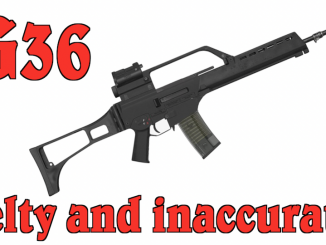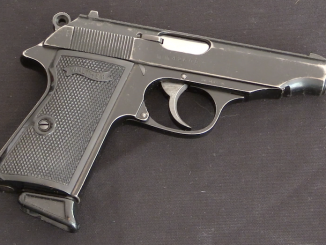In 1934 (just year before officially requesting that the Western world call his country “Iran” rather than “Persia”), the Shah of Iran ordered 4,000 Luger pistols form the Mauser company. These were to be divided between 3,000 standard P08 models and 1,000 LP08 artillery models (plus a handful of cutaways, interestingly). The guns were delivered in 1935 and 1936, and are unique for having all of their markings printed in Farsi, including the serial numbers, model designation, safety, and even Mauser’s name.
Sold for $7,475 (Artillery) and $6,900 (standard) at the December 2019 RIA Premier auction.




Localized markings make sense when the intended export users can’t read the manufacturer’s language. I have to wonder how the markings were put on the parts. Did someone ask for a craftsman to etch/imprint the text?
My guess is that they are roll stamped. Making a roll stamp to imprint Farci wouldn’t be any different than making one that imprinted any other script. I have two 9.5 x 60R mm 7186 Mausers, both a rifle and carbine, which are marked in Turkish script and are definitely not hand stamped or engraved.
Al
Yeah, but first make tools for those unique characters. That is not easy at all.
Marking looks like oxi acetylene torch with pantoghraph. Some of German origin gun factories of past had used it.
That is my question too. Consider all of European languages (part of some but not all Slavic) use of Latin characters. This is something completely different. There must have been a special vendor for this kind of work with exorbitant cost involved. Who would be so much concerned to have a foreign product with their native inscriptions on it? I do not get it.
I’m pretty sure (prior to modern electronic methods) most stamping tooling was handcrafted by experts anyway.
There are obvious exceptions (such as some serial numbers) where the digits are a little “off” in vertical position, etc., but it’s also clear in many cases – national crests, of course, but also the (standard) Mauser logo itself (where the letters are stylized and have a double-arched taper toward the middle) – that they didn’t just take some mass-produced letters and numbers out of a bin and set them up in rows. Economies of scale amortize the costs over tens of thousands of products.
Even if it did cost more, I agree with the Persians, and would ask the converse of your question: What government would specify and pay for illegible foreign text on their weapons? Take the example of FN M-16s: even though it’s all in the Latin alphabet and most Americans could figure it out, their markings aren’t in Flemish or Walloon.
All right, sound reasoning. However, I suggest to look at any of those characters – there is no one straight line in it like we have. How well you duplicate something what is, by its very nature “approximation”. You deviate slightly and it means entirely different word/ meaning.
I guess type-casters, from time papers were actually printed, would have some answers, but I am afraid that profession disappeared and with that the knowledge.
Agreed – I certainly wouldn’t want to take on that task myself!
Fortunately, it sounds like Keith from England (comment down the page) is keeping the flame of that knowledge alive.
That is not just a screwdriver you pulled out of the holster pocket — it’s primary purpose was to assist with loading the magazine. The hole in the loading tool is placed over the magazine follower button and then you can press down tool thumb lever for loading cartridges.
The screwdriver feature was added as an afterthought.
The production of the rolls is probably along the same lines as the production of coin dies, or even of the engraving on trophies and brass nameplates…
In the case of coin dies and the Farsi script, an artist or calligrapher would create the original in plaster or wax, at several times the intended scale (5x or perhaps even 10x).
The calligrapher may well have been the Shah’s own, and based in Tehran,
Then the die makers would use a pantograph to engrave the dies or rolls at the reduced scale, directly from the large scale original, and carefully hand finish them.
Suitable pantographs were made by the likes of Deckel, with their origins in stamping out leaf shutters for the German camera industry
And Taylor Hobson, who seem to have been into precision measurement equipment.
The pantographs are cheap second hand, especially compared to Deckel milling machines and their accessories.
So long as you have the feed rate set correctly to the scale you’re using, there’s no real problem converting a flat original onto a cylindrical surface.
Even for fairly large runs, you can adapt a metal shaper to do the roll stamping.
For present day coin dies, where the coin frequently has a cheap mild steel core (in the commodities boom a few years ago, American Nickels, were actually worth slightly more than their face value, for their nickel and copper content!), and production runs are very large
There’s probably an intermediate step of cutting edm electrodes, to form and finish carbide dies from.
Inter war work from Mauser, Brno and Gdansk, is beautifully finished
Are there Mauser’s with a Gdansk factory rollmark?
Probably not but there are guns galore with everything from no markings whatever to script beyond description that seemed to be no problem for the manufactures. Look at the very common French guns with their cursive script on the! Believe me it’s no issue for the arsenals to put whatever they want onto gun.
Al
Danzig, but not Gdansk.
Dude, you are exactly right! Making a roll die with such machines, and they were well developed by the turn of the century, was almost nothing to factories like DWM and Mauser. Good Lord they may have even outsourced the manufacture of the dies to an outside company that specialized in such things. Now days it’s of course different but never forget that those folks back then had talent every bit as good as is out there today! Now for better or worse we have computers to make it easier for us. Today a picture of the script can be turned into a die in short order with little physical talent, ie engraving ability involved beyond touch-up and polishing the finished die.
Some of these guys are picking the flyshit out of the pepper when they have obviously no inkling of how well developed and precise machine tools were back in the late 1800 and early 1900s. Good Lord, just look at the machinery, talent and fixturing it took to produce those freaking beautiful pistols and then tell me it would have been too difficult to make a set of dies that would roll anything that could come out of a pen into a piece of steel!
I owned a good sized machine shop for some 35 years and believe me, it would have been no problem to purchase, (were one available)a tracer or photograph mill and make dies to roll that script into about any metal part.
Cheers,
Al
It’s possible that supplying the Farsi stamps, or patterns to make stamps was part of the contract. In terms of skills and proficiency Farsi script is no different than scrollwork or damascene and plenty of engravers could do that.
With so many Chinese studying in English speaking places, the Chingrish of Taiwanese, Chinese, and sometimes even Hong Kong instructions manuals, seems to be dying out.
The same with some of the howlers in old Instructions manuals and sales brochures from Germany
It seems like just about all Germans under the age of fifty, can write very good English now.
I really wouldn’t like to think what darkly humorous results, an early 1930s German engraver might accidentally produce in Farsi.
Or perhaps a secretive collector in Iran, is quietly sitting on a hilariously engraved pre production sample, that no one dared to show to the senior officers.
Do we have anyone in the commentariate, who reads Farsi?
One of the guns that Ian has shown us – might be that sample
AS for “why in Farsi” ? It’s called nationalism, which had an upsurge in the Middle East in the Thirties. Lugers with Farsi markings has the same origin as “Don’t call us Persians, we’re Iranians” (which is what they have called themselves for at least 3,000 years.